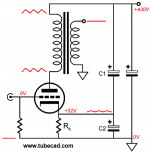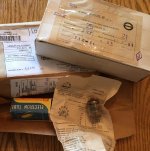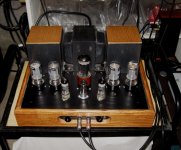I mentioned a "fancy", true, full wave multiplier earlier. The link worked/works, at least for a while. I snipped the graphic out, for safe keeping, and I've uploaded it.
The setup is truly differential and you could ground any of the bridge junctions to obtain a bipolar supply that's either symmetrical or asymmetrical. I see no reason why 'lytics could not be used in the central "spine". However, those "arm" caps. are carrying AC and I'd want film parts known to handle AC well, in those positions. This is, obviously, not an inexpensive setup to implement, but somebody with a big, honking, power trafo salvaged from a SS power amp, whose access to magnetics is limited, could put it to use in tubed power amp circuitry.
The setup is truly differential and you could ground any of the bridge junctions to obtain a bipolar supply that's either symmetrical or asymmetrical. I see no reason why 'lytics could not be used in the central "spine". However, those "arm" caps. are carrying AC and I'd want film parts known to handle AC well, in those positions. This is, obviously, not an inexpensive setup to implement, but somebody with a big, honking, power trafo salvaged from a SS power amp, whose access to magnetics is limited, could put it to use in tubed power amp circuitry.
Attachments
Member
Joined 2009
Paid Member
I don't think he has voltage he can spare for an RC filter, maybe a rather large cap and small value resistor will be enough and not lose too many volts.
agree. but he could instead use loftin-white noise cancelling.
1. Do ultrapath instead of cathode by-pass
2. use an CR network from cathode to cathode
3. make the "R" potentiometer a bit higher than the Rp of the driver valve./tube
4. be ready to experiment a bit and adjust somewhat.
You can also use this network even if you are not direct coupled, and even if you use a CCS on the driver (like I do). Works a charm. no noise. all the transients and bass too.. phenomenal.. (ok I get off my soap box now).
Calculation of the Cap is not hard to do. You are only trying to cancel 50 or 60 Hz... ~2uF should do it in most cases, but you can easily calculate the value... cheap polyester is fine for cancelling psu "rumble".
Ian
Last edited:
Member
Joined 2009
Paid Member
Post #420 "Another option is the WE connection, a small cap from cathode to B+ would also provide a null for the ripple"1. Do ultrapath instead of cathode by-pass
Post #420 "Another option is the WE connection, a small cap from cathode to B+ would also provide a null for the ripple"
This cap does more than one thing. Don't forget that its nice to have some nice stiff bass. On my amplifier with 2a3, I calculated 45uF for 5Hz.
Bob Marley never sounded so good.
Member
Joined 2009
Paid Member
Ah, bud the spud. 😉 But you really need a driver for 2a3 to get something decent out of it.
I built a few variations of Broskie's se aikido too, but it never sounded as good as my pp 2a3. For SE, I prefer the L-W approach from 1929 but everyone here probably knows that by now.
There are of course many other ways to do SE. Well executed transformer coupled SE is also great. I hear that Hammond has some pretty decent interstage too. Never tried them though.
I built a few variations of Broskie's se aikido too, but it never sounded as good as my pp 2a3. For SE, I prefer the L-W approach from 1929 but everyone here probably knows that by now.
There are of course many other ways to do SE. Well executed transformer coupled SE is also great. I hear that Hammond has some pretty decent interstage too. Never tried them though.
Last edited:
Member
Joined 2009
Paid Member
I will be building my own 2A3 as a L-W [http://www.diyaudio.com/forums/tubes-valves/221739-nice-little-valve-amplifier.html ] but the purpose of this thread is Ron's amplifier not mine and he's designing around a cap-coupled amplifier design that I think will work well. I hope Ron is OK.
Member
Joined 2009
Paid Member
Some tubes arrived today...
These are 6J9P, something like E180F
nice tubes there Bigun, i have had very happy experience with those tubes...
Member
Joined 2009
Paid Member
I have to say, they look really nice. I can see the internal structures clearly because it has parallel anodes instead of cylindrical - can't wait to see them glow.
And also, something minor. But the packaging is very nice for me. Not the antiseptic plastic packaging everything comes in these days in North America. This was packaged by hand, nicely wrapped in good quality (thick not paper-like) brown paper. It is something I love about the former USSR traders.
And also, something minor. But the packaging is very nice for me. Not the antiseptic plastic packaging everything comes in these days in North America. This was packaged by hand, nicely wrapped in good quality (thick not paper-like) brown paper. It is something I love about the former USSR traders.
you may also want to try the 12HL7 as drivers, wired triode, they also rock....
i have built two other amps using the D3a and the 12hl7 stands toe to toe...
i have built two other amps using the D3a and the 12hl7 stands toe to toe...
Member
Joined 2009
Paid Member
^yes, that is why i am thinking modules for these drivers to facilitate tube changes.....
pete millet high gm pentodes testing....http://www.pmillett.com/pentodes.htm
pete millet high gm pentodes testing....http://www.pmillett.com/pentodes.htm
Member
Joined 2009
Paid Member
I'm thinking I don't want to try so many options - I believe that I should be quite happy in picking the best from 3 different drivers and letting Ron know my observations - he may wish to go a different direction of course but it's all for fun.
I would like to try the 6J9P triode-wired, also the 12AX7 with higher B+ for the driver, and for the 3rd choice I'm still undecided !
I would like to try the 6J9P triode-wired, also the 12AX7 with higher B+ for the driver, and for the 3rd choice I'm still undecided !
Member
Joined 2009
Paid Member
Member
Joined 2009
Paid Member
- Status
- Not open for further replies.
- Home
- Amplifiers
- Tubes / Valves
- 2A3 driver



